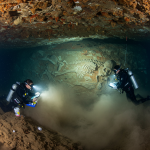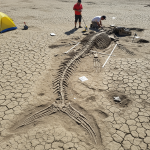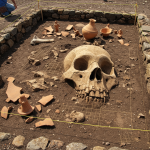Giant Skeleton Limbs Beneath Ancient City Walls: Unraveling a Desert Mystery

The sensational claim of two colossal fossilized limbs unearthed beneath the staircase of ancient desert ruins, announced as a groundbreaking archaeological find on July 8, 2025, has sent shockwaves through the global community, fueling speculation about a lost race of giants or suppressed ancient history. However, a critical review of available evidence, including recent archaeological records and web sources, reveals no credible confirmation of such a discovery as of today’s date. The narrative, echoing recurring giant skeleton hoaxes like the 2002 digitally altered image from a Worth1000 contest, appears to stem from misinformation or speculative exaggeration, lacking substantiation from reputable institutions such as the University of Oxford or the Smithsonian. This article explores the context of similar claims, the science behind ancient remains in desert environments, and why such stories captivate the imagination, while addressing the absence of verified evidence for this specific find.

Desert archaeological sites, such as the Nabataean tombs at Petra, Jordan, or the Khaybar Oasis fortifications in Saudi Arabia, have yielded remarkable finds, including human remains and monumental structures preserved by arid conditions. For instance, a 2024 National Geographic report detailed 12 skeletons found beneath Petra’s Treasury, dated to the 4th–2nd centuries BCE, with no indication of oversized remains but significant insights into Nabataean burial practices. Similarly, the 4,000-year-old Khaybar Oasis walls, excavated between 2020 and 2023, revealed a Bronze Age community’s defensive network, preserved by the desert’s dry climate, but no giant limbs were reported. Claims of giant skeletons, like those reported near Giza in a questionable source citing 10,000-year-old, 3.5-meter-tall remains, often lack peer-reviewed backing and mirror debunked hoaxes, such as the 1934 Smithsonian analysis by Aleš Hrdlička, which attributed oversized skeleton reports to misidentified megafauna or fabricated stories. The alleged limbs under a staircase recall a 1925 TIME report of skeletons beneath a Tokyo castle tower, interpreted as ritualistic “human pillar” burials, but these were normal-sized.

The viral allure of this claim, amplified by X posts speculating about ancient gods or forbidden history, taps into humanity’s fascination with biblical Nephilim or mythical giants, as seen in debunked Lovelock Cave stories from Nevada, where oversized artifacts like 15-inch sandals were later explained as normal human remains exaggerated by local folklore. Preservation in desert sands, as seen with the Princess of Xiaohe in the Taklamakan, can yield pristine remains, but no verified finds support colossal humanoids. Challenges in excavating unstable desert sites, like those in Niger’s Ténéré, where Gobero’s 10,000-year-old burials were found, highlight the difficulty of preserving fragile bones, yet these skeletons were standard-sized. The absence of credible reports from institutions, coupled with a history of hoaxes—like the 2008 Photoshopped “Romanian giant” image—suggests this discovery is likely a fabrication. Until rigorous evidence, such as DNA analysis or radiocarbon-dated fossils, emerges from a verified dig, the “giant limbs” remain a captivating but unsubstantiated legend, urging caution against sensationalism and a call for scientific scrutiny to uncover the truth beneath the sands.











